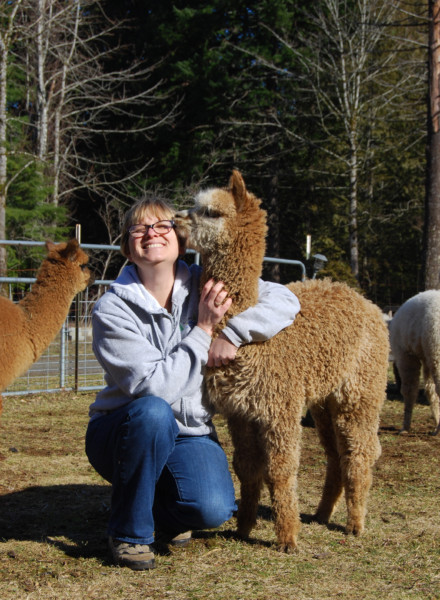By Lori Kimbel
Alan and Angela Rogers of Cedar Creek Alpacas will be having an open farm weekend June 11 & 12 at their farm, which is located at 182 McNichols in Cook, Washington. Farm tours will be from 10 a.m. to 4 p.m. on both Saturday and Sunday.
It will be a fun-filled weekend with all things alpaca. They will be featuring their first ever Fleece to Fashion Spin In. It all begins with the shearing of a couple of alpacas at 10 a.m. and 11 a.m. on both Saturday and Sunday, then the Penninsula Fiberistas will be demonstrating their spinning and weaving skills. Spinners with their own wheel are welcome to join in on the fun and creativity.
Local Gorge band Blunami will provide rhythm and blues musical entertainment Saturday at noon.
Be sure to check out the Farm Store as well, which will be open from 10 a.m. to 4 p.m. Saturday and Sunday. Felted art, woven scarves, handspun yarn, alpaca rugs, hats and gloves and socks are all in stock. Credit cards are welcome.
Alpacas came to the United States in the mid-1980’s. They are a domesticated member of the camel family and live between 15-20 years. They weigh between 10 and 17 pounds at birth then grow to between 100 and 190 pounds as adults.
“I fell in love with them right from the start,” said Angela. “Everything about them is beautiful and worth it. They are easy to care for and you only have to shear them once a year.”
There are approximately 40 alpacas at the Cedar Creek Alpaca farm. “With this many alpacas we have a wide range of personalities,” said Angela. “From the very beginning, with the first six, we had shy ones and friendly ones. Some are shy and keep their distance, some walk right up to us and like to be touched. We have our kissy face alpacas like Ruby and Teddy, and then we have the girls, or boys that for some reason just prefer to hang with the herd. Of course when food is involved most will eat from our hand; they are quite easy to handle due to their size. I would say 95% do not want the top of their head touched. When people pet them we let them know this so that they start with their neck. They are easy to halter-train, so they can be led around, and in and out of trailers for transport. They are a herd animal, so they would get very lonely if they do not have another alpaca around. We always say they are like potato chips, you can’t have just one.”
One of the reasons the Rogers’ raise alpacas is so they can help other people get into this type of business.
“Alpacas are very appealing to people with little to no livestock experience,” said Angela. “They are easy to handle, do not require grooming, and are easy on the land. I like to consider them an alternative to traditional livestock. Their main purpose is the luxurious fleece they produce. They are great as a hobby, or can be a profitable business with the usual work that farming, or owning a business requires. There are good tax benefits as well.”
Of course any business comes with its own set of trials.
“As with any business there are challenges,” said Angela. “It may be something simple like finding a hay grower, or more difficult like diagnosing an illness. For us we take each challenge as a learning experience. We did not have very much experience in raising livestock year round. Our son had 4-H hogs for several years. There is a big difference between hogs and alpacas. I have to say alpacas are much more adorable! The alpaca community is very supportive. We are all still learning things. Alpacas have only been in the country since the 1980’s. The alpaca fleece industry is growing and there is more demand for the fiber now. High end designers are buying. It is a great time to be in the industry!”
In addition to the animals Angela also enjoys weaving and felting.
“When we first purchased the alpacas I didn’t have a clue how to do anything with the fleece. I was a crafty person, so naturally I searched out tutorials on felting. My stepmom is a spinner, weaver and knitter so I got real lucky there to have a family member be able to teach me these things. Now that I spin the fiber into yarn it gives me a better understanding of the qualities of fleece to breed for. It helps me to make better breeding decisions. I am now teaching others these skills. It is fun to share my knowledge of the alpacas and the fiber they produce,” she said.

7 Comments
Comments are closed.